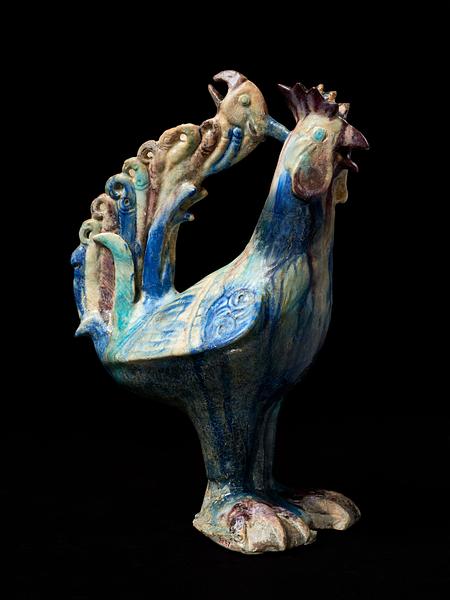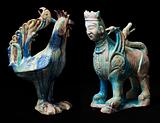It was difficult to make and fire large ceramic figures like this one and the sphinx (
Isl 56) with the technology of the day. They easily crackled or simply collapsed. The manganese, turquoise, and blue glazes and carved decoration are typical of
laqabi ware, but while the glazes on a horizontal surface are kept in place by the carved decoration, this is not the case on an upright object like this one.
Although both animals must be considered mythical creatures, the artist managed to depict the watchful and aggressive cock with all of this animal’s natural characteristics.
Inv. no. Isl 57
Published in:
Athar-e Iran, 1936, 1:1, fig. 127, p. 138 (no photo);
Ernst J. Grube: “Islamic sculpture: ceramic figurines” in Oriental art. N.S., 12:3, 1966, fig. 5, p. 168;
Vilhelm Slomann: Bicorporates: studies in revivals and migrations of art motifs, ed. Ulla Haastrup, Copenhagen 1967, vol. 1, p. 47 and vol. 2, fig. 179;
C .L. Davids Samling. Fjerde Del : Jubilæumsskrift 1945-70, København 1970, cat.no. 1, p. 269;
André Leth: Davids Samling. Islamisk kunst = The David Collection. Islamic Art, København 1975, p. 34;
Art from the World of Islam. 8th-18th century, Louisiana, Humlebæk 1987, cat.no. 83;
Kjeld von Folsach: Islamic art. The David Collection, Copenhagen 1990, cat.no.128;
Kjeld von Folsach: Fabelvæsner fra Islams Verden, Davids Samling, København 1991, cat.no. 25;
Kjeld von Folsach, Torben Lundbæk and Peder Mortensen (eds.): Sultan, Shah and Great Mughal: the history and culture of the Islamic world, The National Museum, Copenhagen 1996, cat.no. 205;
Kjeld von Folsach: Art from the World of Islam in The David Collection, Copenhagen 2001, cat.no. 186;
Eric Delpont (ed.): L'Orient de Saladin: l'art des Ayyoubides: exposition présentée à l'Institut du monde arabe, Paris du 23 octobre 2001 au 10 mars 2002, Institut du monde arabe, Paris 2001, cat.no. 51, pp. 56-57;
Almut v. Gladiss (ed.): Die Dschazira: Kulturlandschaft zwischen Euphrat und Tigris, Museum für Islamische Kunst, Berlin 2006, cat.no. 5, pp. 43-46;
Kjeld von Folsach: “Paradise on earth: water and the Islamic garden” in John Kuhlmann Madsen, Nils Overgaard Andersen and Ingolf Thuesen (eds.): Water of life: essays from a symposium held on the occasion of Peder Mortensen's 80th birthday, Copenhagen 2016, p. 191, fig. 5;
Sheila R. Canby [et al.]: Court and cosmos: the great age of the Seljuqs, Metropolitan Museum of Art, New York, New Haven 2016, cat.no. 132, pp. 214-215;



